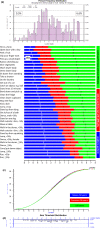The facioscapulohumeral muscular dystrophy Rasch-built overall disability scale (FSHD-RODS)
- PMID: 33838063
- PMCID: PMC8251612
- DOI: 10.1111/ene.14863
The facioscapulohumeral muscular dystrophy Rasch-built overall disability scale (FSHD-RODS)
Abstract
Background and objectives: Facioscapulohumeral muscular dystrophy (FHSD) is a debilitating inherited muscle disease for which various therapeutic strategies are being investigated. Thus far, little attention has been given in FSHD to the development of scientifically sound outcome measures fulfilling regulatory authority requirements. The aim of this study was to design a patient-reported Rasch-built interval scale on activity and participation for FSHD.
Methods: A pre-phase FSHD-Rasch-built overall disability scale (pre-FSHD-RODS; consisting of 159 activity/participation items), based on the World Health Organization international classification of disease-related functional consequences was completed by 762 FSHD patients (Netherlands: n = 171; UK: n = 287; United States: n = 221; France: n = 52; Australia: n = 32). A proportion of the patient cohort completed it twice (n = 230; interval 2-4 weeks; reliability studies). The pre-FSHD-RODS was subjected to Rasch analyses to create a model fulfilling its requirements. Validity studies were performed through correlation with the motor function measure.
Results: The pre-FSHD-RODS did not meet the Rasch model expectations. Based on determinants such as misfit statistics and misfit residuals, differential item functioning, and local dependency, we systematically removed items until a final 38-inquiry (originating from 32 items; six items split) FSHD-RODS was constructed achieving Rasch model expectations. Adequate test-retest reliability and (cross-cultural and external) validity scores were obtained.
Conclusions: The FSHD-RODS is a disease-specific interval measure suitable for detecting activity and participation restrictions in patients with FSHD with good item/person reliability and validity scores. The use of this scale is recommended in the near future, to determine the functional deterioration slope in FSHD per year as a preparation for the upcoming clinical intervention trials in FSHD.
Keywords: FSHD; Rasch-built disability scale; activity and participation; facioscapulohumeral dystrophy; outcome research; reliability; validity.
© 2021 The Authors. European Journal of Neurology published by John Wiley & Sons Ltd on behalf of European Academy of Neurology.
Conflict of interest statement
The authors report no conflicts of interest relevant to the current research.
Figures




References
-
- Mul K, Lassche S, Voermans NC, et al. What's in a name? The clinical features of facioscapulohumeral muscular dystrophy. Pract Neurol. 2016;16(3):201‐207. - PubMed
-
- Biomarkers Definitions Working Group . Biomarkers and surrogate endpoints: preferred definitions and conceptual framework. Clin Pharmacol Ther, 2001;69(3):89‐95. - PubMed
Publication types
MeSH terms
LinkOut - more resources
Full Text Sources
Other Literature Sources
Medical

